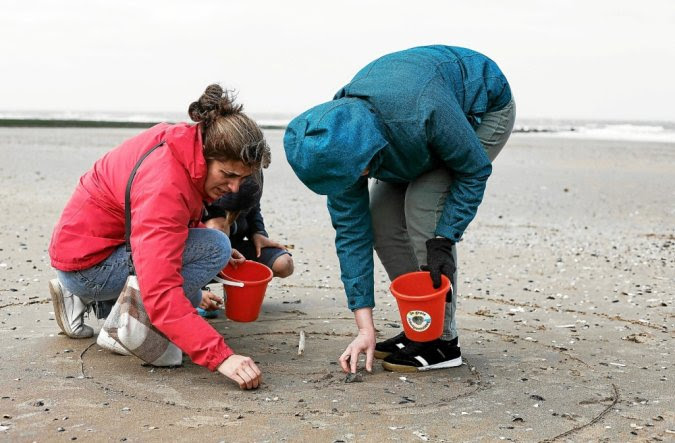During this last event, the mother, Natascha and her children draw a big spiral in the sand. Armed with plastic buckets, they collect the shells inside their drawing before bringing them back to the beach, where they are carefully sorted by volunteers, then counted and recorded by species.
“We have to collect all the shells that aren’t broken,” says Natascha Perales, 40, a first-time participant in the initiative. “We found mussels, oysters, cockles… At least six different species. It’s a great activity despite the weather,” she smiles.
However, the climate was not clement, with terrible gusts of wind, but this did not discourage the ten participants who take turns at the stand in Middelkerke (northern Belgium). Laurence Virolée, 41, came with her three children: “We learned a lot. Last year, we had already participated in a beach cleaning day. It’s important for children to see the evolution of biodiversity and to make them aware of climate facts”.
More than 800 shell counters participated in the operation which took place simultaneously in Belgium, the Netherlands and, for the first time, France.
More than 38,000 shells were counted, about the same number as in 2022.
“Shellfish are a good indicator of the state of biodiversity in the North Sea,” says Jan Seys of the Flemish Institute of the Sea (VLIZ), organizer of the annual event.
“Last year, 15% of the shells found belonged to exotic species” – particularly watched by scientists who fear they are invasive. “We have seen for example American species appearing on our coasts”, like the American knife, explains Jan Seys.
Close to the shore, Joris Hooze, 75 years old, proposes to the participants to observe the mollusks with a microscope and to learn to distinguish their particularities.
He is a retired biologist, he belongs to a Belgian association dedicated to the observation of marine biology. “We have observed that organisms normally living in warm waters are appearing more and more on the coast,” he explains. For him, “this is a sign of climate change.
Brussels, committed in early March to devote more than 800 million euros to the protection of the oceans.
“Europe wants to restore our oceans by 2030. If we want to achieve this goal, we need the public. And this type of initiative allows us to raise public awareness of these issues,” comments Jan Seys.
In the year 2023, the shells with holes in them were the focus of the attention of scientists who want to determine how many predatory snails threaten the shellfish.



Comment here